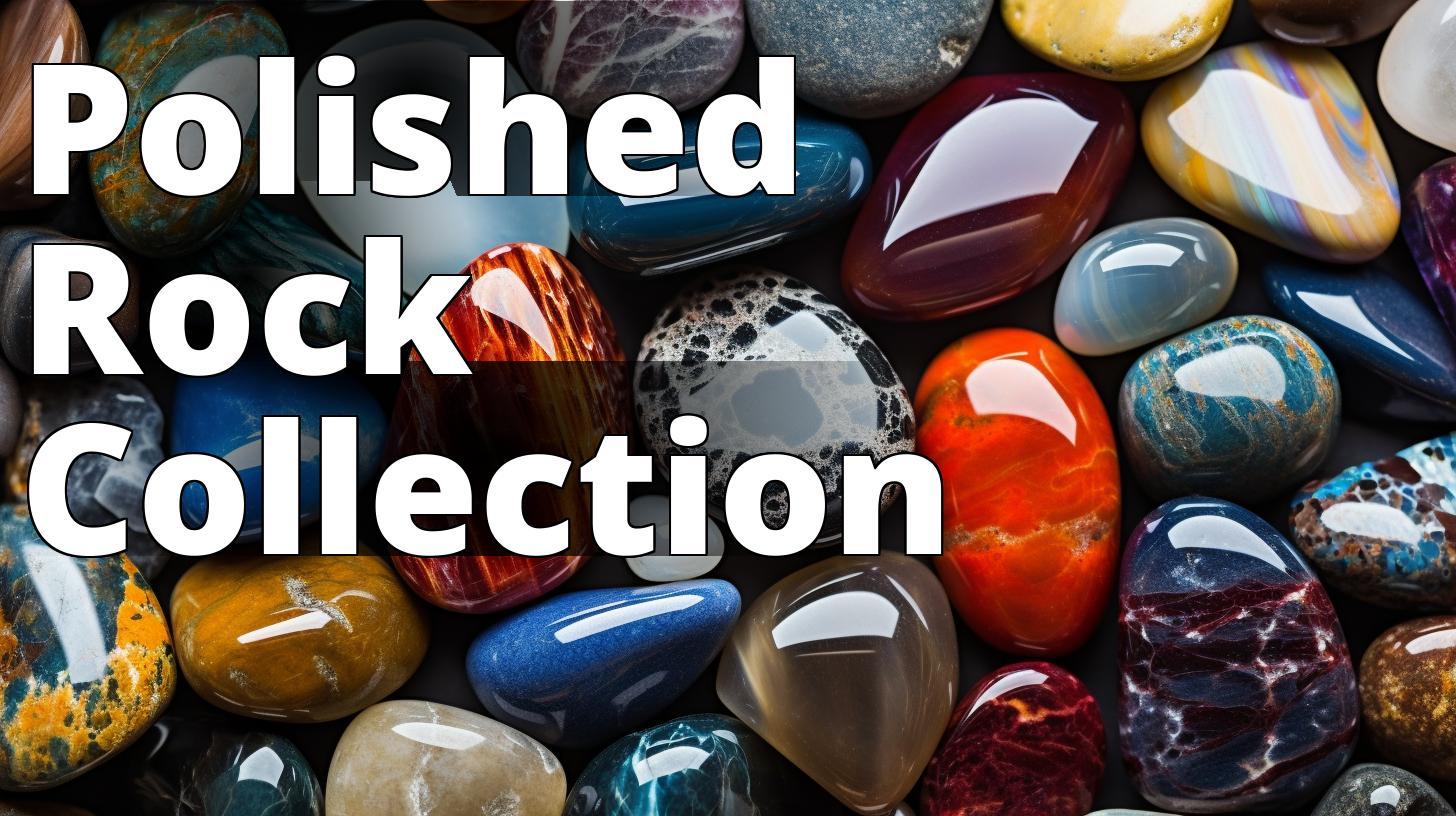Are you interested in lapidary and wondering how to choose the right rocks for polishing? Lapidary, which involves cutting, shaping, and polishing stones and minerals, is a fascinating hobby that requires patience, skill, and attention to detail. Selecting the best rocks for tumbling is crucial for achieving the best results. In this article, we’ll provide a comprehensive guide to choosing the best rocks for polishing, including their characteristics, types, sources, and tips for preparing them for tumbling.

Characteristics of Rocks Suitable for Polishing
When selecting rocks for polishing, several characteristics should be considered. The following qualities are essential for achieving a smooth, glossy finish:
Hardness
The hardness of a rock is measured on the Mohs hardness scale, which ranges from 1 (softest) to 10 (hardest). Rocks with a hardness level of 7 or higher are recommended for tumbling, as they will not wear down too quickly or break during the polishing process. Some examples of rocks that meet this criterion include quartz, agate, and jasper.
Density
Denser rocks are better for polishing because they can withstand the pressure and abrasion of the tumbling process. They also tend to produce a higher-quality finish. Some examples of dense rocks that are suitable for tumbling include petrified wood, basalt, and granite.
Smoothness
It’s important to select rocks with a smooth surface to prevent scratches during polishing. Rocks with a rough or textured surface may require additional sanding or pre-polishing before they can be tumbled. Some rocks that are naturally smooth and require minimal preparation include river rocks, beach pebbles, and tumbled glass.
Lack of Fractures
Rocks with fractures or cracks are more likely to break or chip during the tumbling process. It’s best to avoid rocks with visible cracks or fissures, or to carefully inspect them before tumbling. Some rocks that are prone to fractures include shale, slate, and schist.
Choosing the Right Rocks for Lapidary Polishing: A Beginner’s Guide
- Characteristics of rocks suitable for polishing include hardness, density, smoothness, and lack of fractures.
- Types of rocks that can be polished include quartz, agate, jasper, sodalite, petrified wood, and others.
- Rocks for polishing can be found through rockhounding, online purchasing, and local rock shops.

Types of Rocks Suitable for Polishing
There are many types of rocks that are suitable for tumbling, each with their unique characteristics and properties. Here are some of the most popular rocks to consider:
Quartz
Quartz is the most commonly used rock for polishing, thanks to its durability and availability. It has a hardness level of 7, which makes it ideal for tumbling. Quartz comes in many different colors and varieties, including clear, rose, and smoky quartz.
According to Rockhound Resource, quartz is a popular choice for lapidary because it’s hard, dense, and comes in many different varieties. It’s also widely available and affordable, making it a great choice for beginners.
Agate
Agate is another popular rock for polishing, known for its unique patterns and colors. It has a hardness level of 7 and can be found in many different varieties, including banded agate, moss agate, and lace agate.
If you are looking for popular rocks to tumble, Rockhound Resource recommends trying out agate. Agate is a great choice for beginners because it’s widely available, affordable, and comes in many different varieties.
Jasper
Jasper is a durable and varied rock that can be polished to a high gloss. It has a hardness level of 7 and comes in many different colors and patterns, including red, yellow, and green jasper.
Wondering why some rocks are better for tumbling than others? Check out Rockhound Resource to learn more about jasper and other popular rocks for lapidary.
Sodalite
Sodalite is a beautiful blue rock with a hardness of 5.5-6 that can be polished to a high shine. It’s a less common rock for tumbling, but it’s worth considering if you’re looking for something unique.
According to a guide on Polishing Expert, sodalite is a good choice for lapidary because it’s hard and takes a good polish. It’s also relatively affordable and can be found in some rock shops and online retailers.
Petrified Wood
Petrified wood is a unique rock formed by the fossilization of wood that can be polished to reveal its natural beauty. It has a hardness level of 7, which makes it suitable for tumbling. Petrified wood comes in many different colors and patterns, including red, brown, and green.
If you’re interested in trying petrified wood for lapidary, Rocktumbler.com recommends looking for pieces that are solid and free of fractures. It’s also important to use a coarse grit to remove any rough spots before polishing.
Other Rocks
There are many other rocks that can be polished successfully, including obsidian, tumbled glass, and rose quartz. These rocks may require additional preparation or care during the tumbling process, so it’s important to do your research before selecting them.

Finding Rocks for Polishing
Once you know what types of rocks you’re looking for, the next step is to find them. Here are some tips for sourcing rocks for lapidary:
Rockhounding
Rockhounding is the practice of collecting rocks and minerals from their natural environment. It’s a great way to find unique and interesting rocks for lapidary. Some popular places to go rockhounding include beaches, riverbeds, and quarries.
According to Polishing Expert, riverbeds are a great place to find rocks for tumbling because the water has already naturally tumbled them. Other good places to look for rocks include construction sites and road cuts.
Online Purchasing
If you’re unable to find rocks locally, or if you’re looking for a specific type of rock, purchasing online may be a good option. When shopping for rocks online, it’s important to evaluate the seller and read product descriptions carefully. Look for sellers with good reviews and detailed photos of the rocks they’re selling.
Local Rock Shops
Local rock shops may carry rocks suitable for polishing, as well as lapidary tools and supplies. Visiting a local rock shop can be a great way to learn more about the hobby and get advice from experienced enthusiasts.

Preparing Rocks for Tumbling
Before tumbling rocks, it’s important to properly prepare them to ensure the best results. Here are some tips for preparing rocks for tumbling:
Cleaning
Start by cleaning the rocks to remove any dirt or debris. You can use a mixture of water and mild soap, or a commercial rock cleaner.
Pre-polishing
If the rocks have a rough or textured surface, you may need to pre-polish them before tumbling. This can be done using a coarse grit on a rotary tool or by hand.
Tumbling
Once the rocks are cleaned and pre-polished, they’re ready for tumbling. Use a tumbler to polish the rocks, following the instructions provided with the machine. Be sure to use the appropriate polishing compound for the specific type of rock you’re tumbling.

Polishing Compounds
| Polishing Compound | Best For |
|---|---|
| Cerium Oxide | Most types of stones |
| Diamond Paste | Harder materials |
| Zam Buffing Compound | Turquoise and softer stones |
Polishing compounds are substances used to polish rocks and minerals. They work by removing a thin layer of the rock’s surface, revealing a smooth, glossy finish. There are several types of polishing compounds available, including:
Cerium Oxide
Cerium oxide is a popular polish for most types of stones. It’s easy to use and produces a high-quality finish.
If you’re wondering what the best polishing compound for rocks is, Rock Seeker recommends cerium oxide as a good polish for most stones. It’s effective and easy to use, making it a popular choice among lapidary enthusiasts.
Diamond Paste
Diamond paste is a more abrasive polish that’s best suited for harder materials. It’s often used for polishing diamonds and other precious stones.
Zam Buffing Compound
Zam buffing compound is a specialized polish that’s best suited for turquoise and softer stones. It produces a high gloss and helps to protect the stone from damage.
When selecting a polishing compound, it’s important to choose one that’s appropriate for the specific rock you’re polishing. Different types of rocks may require different types of compounds or different amounts of pressure.
Anecdote: The Importance of Choosing the Right Rocks
As a beginner in the world of lapidary, I learned the hard way just how important it is to choose the right rocks for polishing. I had found a beautiful piece of quartz on a hike and was eager to turn it into a shiny gemstone. Without doing my research, I threw it in with some other rocks I had collected and started the tumbling process.
After several days, I opened the tumbler to find that my quartz was not only still rough and dull, but it had also scratched and damaged many of the other rocks in the batch. I was devastated. It wasn’t until I did some more reading that I realized my mistake – quartz is a hard and dense rock that requires a specific type of polishing compound and careful attention during the tumbling process.
Since then, I have made sure to do my research and carefully select the rocks I use for polishing. I’ve had much better success and have even discovered some new favorite stones along the way. Choosing the right rocks is not only important for achieving a beautiful end result, but it also saves time, money, and frustration in the long run.
Conclusion
Choosing the right rocks for lapidary polishing is essential for achieving the best results. By considering the hardness, density, smoothness, and lack of fractures of different rocks, you can select the best ones for tumbling. Some popular rocks for lapidary include quartz, agate, jasper, and petrified wood. By rockhounding, purchasing online, or visiting local rock shops, you can find a variety of rocks to work with. And by using the right polishing compound and properly preparing the rocks for tumbling, you can achieve a smooth, glossy finish. Remember to be patient, take your time, and enjoy the process of lapidary polishing.
Insider Tip: When rockhounding, be sure to obtain any necessary permits or permissions before collecting rocks from public lands. This will ensure that you stay safe and legal while pursuing your lapidary hobby.

